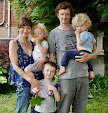
Oh dear. What have we here?
It looks like Salvador Dali baked a loaf of bread.
It's as if this loaf of bread is wearing a military beret.
It's a loaf of bread with the 'scene' hair of an emo kid.
I found this Country Loaf recipe in my "Best Of Chef At Home" cookbook. It promised the most delicious loaf of bread with time acting as the magic element rather than athletic kneading. I'd awoken the other morning, after the dough's lengthy overnight rise, with dreams of that impossibly enchanting 'fresh bread' baking smell, thick slices just cut, still steaming, slashes of butter melting on top.
I've never been a confident baker. Everything I make has the taste of 'amateur.' But the idea of making bread has long been a culinary daydream of mine. When I think of bread making, I have these impossibly romantic images of Italian kitchens, high up on the hillsides, flooded with melted-butter sun. You can see flour particles dancing in the beams of light that stream through the open shutter windows while some dark eyed Italian goddess kneads the dough, calmly, expertly, on the sort of harvest table I covet, fantasizing about Giancarlo in the next village as her husband tends the olive groves.

Yet the experience I had, in my kitchen in downtown Toronto, wasn't quite so cinematic. Nervous and flour-spattered, I consulted the rather simple recipe obsessively. Michael Smith said to knead the dough for 'moments' after the overnight rise; Was he equating moments with minutes? Or seconds? I spent the entirety of the second rise pondering my possible mistakes.
When Almost Husband and I were in Brugges last year, we stayed at this gorgeous bed and breakfast, where the landlady baked fresh breads and rolls every morning. Using only the most natural ingredients and getting her flour directly from a local grain miller, I fancied her to be something of an expert in the art of bread making. I asked her one morning what secrets she could part with to making a good bread. Her response was not the one I was expecting. There were no assertions of following recipes with a scientific precision. She simply experimented. "Some days, I get it wrong, " she said. "You just have to try different things and not be scared to experiment."

So maybe, then, all this time, I've had the wrong idea. Maybe focusing on "doing it right" won't actually yield a delicious bread. Maybe the expectation - 'if you follow the rules, everything will turn out perfectly' - isn't realistic enough a principle to embrace in baking.
By the time the dough completed it's second rise and Demonic Oven was ready to work its voodoo, I could tell this wouldn't be a beautiful loaf. It had waterfall-ed over the side of the too small pan, and the dough seemed a bit too light and airy.
So I ended up with a ridiculous looking loaf. And I had to laugh. Because as someone who is at times fixated on reaching perfection, this was as far from it as I could get. This loaf was a big "F**k you" to my perfectionism. And in a way, this loaf was a representation of myself. A little unbalanced. Gritty, at times. And with a story underneath that explains all the hopefully delightful flaws.

So bread making, it would seem, isn't simply about yielding bread. It's analogous with life itself.
Country Loaf, via Michael Smith's "Best Of Chef At Home":
3 cups all-purpose or bread flour
1 cup whole wheat flour
1/2 cup of any multi-grain mix (I used Red River Cereal)
1/2 heaping tsp dry active yeast
2 tsp salt
2 1/4 cups warm water
Directions:
1. In large bowl, combine all the dry ingredients and mix well. Add the warm water and stir with the handle of a wooden spoon until a moist dough forms. Continue stirring vigorously until all the loose flour is incorporated into the dough, 1-2 minutes.
2. Cover the bowl with plastic wrap and let rest in a warm place for 12-14 hours. The dough should double in size and bubble.
3. Dust the dough lightly and oil your hands a bit, to gather the dough from the outside edges to the middle. Knock it down into a loose ball. Turn out onto a lightly floured surface and knead for a few moments until a tight ball forms. Put the ball back in the bowl and lightly coat it with a splash of oil, turning to evenly cover.
4. Gently roll the dough into a thick log that fits end to end in a lightly oiled 9" x 5" (2L) loaf pan and, without covering, rest it a second time. In 2-3 hours, it will again double in size. At this time, preheat the oven to 425 degrees F, and when the dough is ready, bake for approx. 45 minutes. Allow to cool completely before slicing (not that I did.)


No comments:
Post a Comment